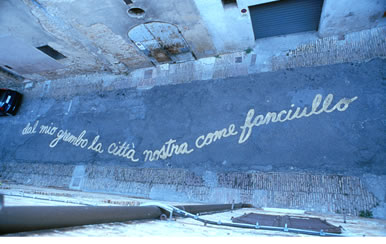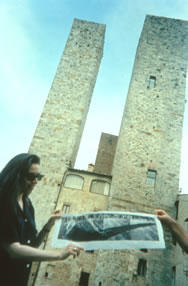 |
Text on Jessica Diamond, Amedeo
Martegani, Marco Cingolani by Jan Hoet
The average tourist visits San Gimignano in the same way as, for example,
the average American or Japanese visits Bruges, Ghent and Brussels - all
in scarcely a day. Meaning: along previously marked routes, without adventure,
without risks. They park the car on the outskirts of the town, stroll
along the town's tourist axis, avoid streets where there are no other
tourists, try out a pavement café, eat a roll or a pizza, take
a couple of totally irrelevant photos, buy a worthless souvenir, leave
the town and drive on to Siena, where more or less the same pattern is
repeated.
To such people, the history of a town is an essentially lifeless matter.
They come to look at a corpse and take an imitation relic of it with them.
Without realizing it in so many words, they see the past as a nostalgic,
isolated and completed spectacle, dead and orphaned in fine façades
and churches, and in a handful of historical anecdotes.
Three young and committed Tuscans now want to help San Gimignano escape
from this dead-end street, using their gallery as a bridgehead and with
the help of living artists. This initiative is not new. Stimulated and
inspired by these three, the town council had itself once before taken
the initiative of challenging contemporary art to a confrontation and
dialogue with their old, fascinating, mysterious and original town. At
that time, surprised and intrigued, I saw work by Luciano Fabro, Jannis
Kounellis, Paolini and other internationally renowned artists.
This time the three gallery owners are taking the initiative themselves.
However, they are not making a commercial killing out of it, by setting
up a cleverly thought-out sales-oriented exhibition in the gallery itself,
but are letting three artists loose on the town, its past and its people.
Three artists from a younger generation than the celebrities just mentioned:
the American Jessica Diamond (whom we in Europe already know from group
exhibitions in London, Ghent, Barcelona and Venice) and the Italians Cingolani
and Martegani, who have already exhibited in this gallery and are now
being given the opportunity to seek out San Gimignano itself, as well
as its history and its daily life. An enterprise that's as worthwhile
as it is risky, which is all the more reason why I am happy to take up
the gallery's request to add a few marginal notes to this initiative.
An initial observation: in the locations they have chosen, Diamond, Cingolani
and Martegani have consciously or unconsciously sought out mainly those
parts of the town and its streets and houses that have not yet been infected
by kitsch and commerce. They wish to address a living and untainted past.
Second observation: their art is about art. Like so many Italian towns,
San Gimignano is in itself art. The three artists are now putting the
question: how did people here think in the past (about beauty, life, communicating)
and what do I have to do today to link up with that, to formulate a response
to it? In short, what do I have to create today in order to carry on living?
 The
subtle play of word and image does indeed become ambiguous in this mixing
of art with art. But essential too. Because otherwise the artists would
be just like the tourists, walking round the town like an open-air museum.
But they The
subtle play of word and image does indeed become ambiguous in this mixing
of art with art. But essential too. Because otherwise the artists would
be just like the tourists, walking round the town like an open-air museum.
But they
do not do that. They speak to the town from the past about life in the
present.
Art is always seeking new paradigms. Even when it integrates into the
fabric of a postmodern reality, where culture seems to be only a part
of a so-called cultural industry, there still appear to be sufficient
signals that draw us into reflection, criticism, poetry and spirituality.
In relation to history, today's artist can offer us input and guarantees
which help us out of this often so infertile nostalgia and generate a
new dynamism. By viewing and reviewing the past in terms of the present.
By not perceiving the past as an isolated phenomenon, but as one passage
in a seamless process, as a pedestal on which the artist gives shape to
his vision and necessity with regard to our present. So that new ideas
and impulses can blossom on old ground.
Diamond, Cingolani, Martegani.
The first casts the shadow, in black and marble, of what is no longer
there. The shadow of one of the dozens of towers that have disappeared
from San Gimignano's skyline. This is how she speaks with and about what
is absent. With the hope of recollection (because even without the tower
you step into its shadow) and the despair of the lost (because the shadow
is broken, like a stick that 'breaks' optically when you immerse it in
water). Elsewhere in the town, in a street with no tourists except those
who are lost, she refers, in the gently curving line of the words chased
in copper, to an old painting in which the patron saint protects his town
in the softly curved valley of his lap. Here too she only just touches
the past, almost invisibly, using it to re-inspire our present.
The second, Cingolani, went to look behind windows where no one had lost
anything, where no one was looking for anything. Windows that do not divulge
their secrets. Not the windows of living rooms or drawing rooms, but windows
of rooms that are empty and out of sight. Windows no one looks at or through.
He replaced the panes with painted glass, showing figures who suddenly
bring the dark, odd corners to life in a flood of light and with a strange,
comically gesticulating commentary. As if, after centuries of silence,
these windows do after all want to divulge the secrets from behind the
glass. Several characters laugh at a curious private joke. But who is
laughing at whom? Are they making ironical comments on the tourists? Perhaps.
The third, Martegani, has created a photographic guide to places the average
tourist knows nothing about, and for which he has no heart. Anyone buying
this guide knows himself to be armed by the artist during his walk. A
walk outside the town. A walk covering the things which, in their hidden
souls, often express more about people and matter than the traditional
over-viewed and over-photographed historical monuments. The stones of
a trifling little church, sentimental objects in a living room: the artist
commits himself to them, points them out for a moment, encroaches a little
on them.And somewhere, in a stronghold on a hilltop, battered by time,
he creates a voice that speaks from the depths of a well. People always
throw stones into a well. Then they wait, till the depth responds in the
echo of a splash. Because people want the well to speak. They want to
taste the mystery of the unfathomable depths. They want to hear what they
cannot see. The artist helps to translate the pattern of our actions.
As well as breaking it. In a moment of reflection and humour. And in a
well that is centuries old. As if the past were speaking once again. With
us and about us.
Who is answering from that well?
Who is that chap in the window grinning at?
Why hasn't that shadow got a tower?
|

|